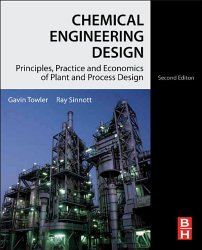Engineering Bookshelf
- Aerospace
- Biological
- Civil
- Chemical
- Environmental
- Electrical
- Materials
- Mechanical
- Petroleum
- Geoengineering
- Software

Chemical Engineering Design: Principles, Practice and Economics of Plant and Process Design
by Gavin Towler, R K SinnottPublisher: Butterworth-Heinemann
ISBN: 0080966594
Check price @ amazon.com , amazon.ca , amazon.co.uk
Book Description
"Bottom line: For a holistic view of chemical engineering design, this book provides as much, if not more, than any other book available on the topic." Extract from Chemical Engineering Resources review.
Chemical Engineering Design is a complete course text for students of chemical engineering. Written for the Senior Design Course, and also suitable for introduction to chemical engineering courses, it covers the basics of unit operations and the latest aspects of process design, equipment selection, plant and operating economics, safety and loss prevention. It is a textbook that students will want to keep through their undergraduate education and on into their professional lives.
New to this edition:
- Revised organization into Part I: Process Design, and Part II: Plant Design. The broad themes of Part I are flowsheet development, economic analysis, safety and environmental impact and optimization. Part II contains chapters on equipment design and selection that can be used as supplements to a lecture course or as essential references for students or practicing engineers working on design projects.
- New discussion of conceptual plant design, flowsheet development and revamp design
- Significantly increased coverage of capital cost estimation, process costing and economics
- New chapters on equipment selection, reactor design and solids handling processes
- New sections on fermentation, adsorption, membrane separations, ion exchange and chromatography
- Increased coverage of batch processing, food, pharmaceutical and biological processes
- All equipment chapters in Part II revised and updated with current information
- Updated throughout for latest US codes and standards, including API, ASME and ISA design codes and ANSI standards
- Additional worked examples and homework problems
About the Author
Ray Sinnott's varied career, mainly in design and development, began with several major companies including Dupont and John Brown. The main areas covered within these appointments were: Gas Production and Distribution, Nuclear Energy, Elastomers and Textile fibres.
After his career in industry he joined the Chemical Engineering Department, University of Wales Swansea in 1970, specialising in teaching process and plant design, and other engineering practice subjects.
The first edition of Chemical Engineering Design (Coulson and Richardson's Vol 6) was published in 1983. Subsequent editions have been published at approximately 5 year intervals.
Ray Sinnott retired from full time teaching in 1995 but has maintained close contact with the engineering profession.
Customer Reviews
By T.M. Reader
My engineering background is in electrical power production rather than chemical engineering (chemistry being a weak subject for me), so I opened this text with some trepidation -- Not to worry! I found this Towler/Scott second edition of "Chemical Engineering Design" to be exceptionally comprehensive, practical/applicable, and the presentation style to be quite accessible. Much more so than the texts I cut my teeth on in the 70's and 80' (I actually rather enjoyed going through this one).
Without breaking down chapter titling, I'll just again say that the content is notably comprehensive (or "holistic", as the back cover info terms it), and current. Beside the core information on process design, such needful issues as cost efficiency and realistic economics, environmental aesthetics, and newer technologies (such as reverse osmosis processes, or such as providing website addresses for obtaining current metal prices) are included.
All the expected chemical process coverage is there (reactions, separations, material properties, etc). I was pleased to see the book close with very hands-on coverage of practical thermodyamics, with coverage on heat exchangers, pumping and piping. Also some nice sections on hazards, safety margin, failure modes and such. Nicely illistrated (generally charts or black/white line diagrams - no photos). Nicely indexed.
Suggested for the student/beginner - but not a bad look through resource for a seasoned designer preparing for a major project or just wanting another input on a narrow problem area.
By Dr. Bojan Tunguz
This is a very informative, exhaustive, and modern chemical engineering design textbook. It covers all essential aspects of chemical design for plants and processes, including, as the subtitle suggests, principles, practices and the economics of such design. It is intended for an advanced undergraduate course, or even for an introductory graduate course in chemical engineering or related fields.
The chapters include: "Process Flowsheet Development," "Instrumentation and Process Control," "Capital Cost Estimating," "General Site Considerations," "Design of Pressure Vessels," "Separation of Fluids," "Transport and Storage of Fluids," and many others. Chapters generally build upon the preceding material, but there are a few that can be skipped if they don't directly align with the course material. The writing is very detailed, with many worked-out examples, tables, graphs and references. Each chapter ends with a set of problems. The problems vary in difficulty, but are generally well suited as a way for testing the understanding of the material in any given chapter. The book also includes 108 realistic design projects from several industries. The book can also be used as a reference for practicing engineers or designers. It is one of the more impressive technical textbooks that I've come across.